Seaside
As I sit here on a plane from Atlanta back to cold and snowy Boston, I think the best word to sum up my state after 4 days in Seaside, Florida is shellshocked. This was the second of my trips for the Knight Fellowship (see my previous Miami posts), we all came down for the Seaside Institute’s three-day Advanced Traditional Neighborhood Design Techniques seminar and managed to pack in Fellowship meetings, unbelieveable dinners, discussions, and debates, and extra tours of other nearby New Urbanist developments in addition to one of the best seminars I have attended. Where do I start?
Seaside, widely recognized as the setting for Jim Carrey’s the Truman Show, is one of the first New Urbanist towns ever built. Construction began in the early 1980s and continues to this day, but the town as it stands now is a model of New Urbanism in many ways. It is laid out centered on a town green on the north side of the state highway that runs along the Florida panhandle coastline. The town green is lined by two and three-story mixed-use buildings - a local market, record store, bookstore, shops, and offices.

Tiny temporary liner buildings serve as business incubators and allow for flexibility as the town evolves through the volatile retail market.
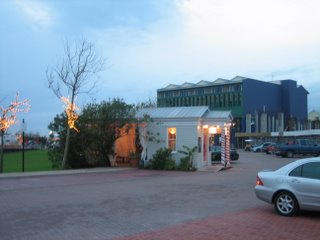
The Seaside post office has its own special spot anchoring the green, and in reality, the whole town.
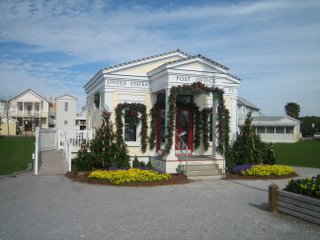
At the seminar, Robert Davis, the town founder (developer isn’t a strong enough word for the monumental achievement of Seaside), and Andres Duany, revolutionary urban designer and leader of the New Urbanism, spoke at length about the strategies they employed during Seaside’s design and mistakes they made. Absolutely riveting to urban design freaks like myself, and a bit surreal to be learning about urbanism from the best of the best in a setting as historic and intensely New Urbanist as Seaside.
Seaside’s New Urbanist bones, the incredibly narrow interconnected streets with informal parallel parking,
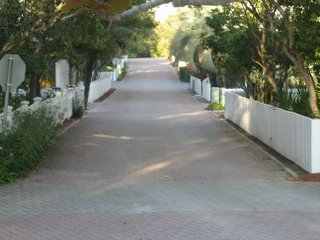
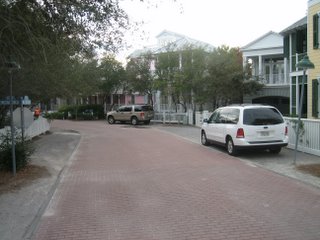

mixed-use buildings and town center,


Charter school,

chapel with formal greenspace,

incredible vista terminations including beach pavilions, the chapel, rotundas, and other town buildings,


and narrow paths behind residential lots,
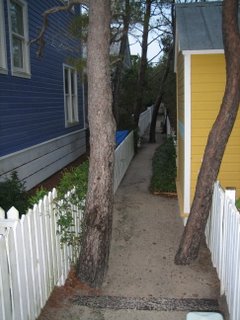
I could go on and on. It was interesting to notice the lack of sidewalks leading to informal low-speed streets and a tighter feeling of enclosure. Classic New Urbanism, which I have never really experienced to this extent. Not even close. One interesting measure of community that I experienced: can you run out for a cup of coffee and a muffin in the 15 minutes before the airport shuttle comes to your house to run you to the airport? In Seaside’s case as I found out, the answer is yes.
The interesting thing about Seaside is that due to its location on the Florida coast, the quality of construction and feeling of community, and the obvious appeal to a market that has been underserved, the value of property has skyrocketed and more than two-thirds of the homes are not owner occupied. Most are multi-million dollar vacation homes, which leads to a strange feeling that we were wandering around a quasi-ghost town. The community feeling was strange, not surprisingly. Seaside is widely identified as a New Urbanist prototype, which is true when looking at the physical urban design DNA, but any criticism of New Urbanism based on Seaside being for the rich only, or too pretty, or as a resort town, is technically true but does not hold up as criticism of New Urbanism. Andres called Seaside a “propaganda machine”, which is exactly how I view it. Seaside’s value comes in those who come to visit based on its reputation and leave with an increased understanding of New Urbanism by living it, breathing it, experiencing it, then take that with them to their region and apply it.
The physical urban design really does facilitate the creation of community, as it did for our fellowship group in four short days. The Fellows were put up in for-rent cottages across the town; I stayed with Geoff Dyer, an urban designer from Calgary, and Kris Smith, a community representative in Miami, in a three bedroom cottage in a neighborhood about four blocks east of the town green. Our cottage:

Almost all cottages have porches, are extremely close to each other, and feature the back path system (called “Krier walks” for Leon Krier who came up with the idea), and show how urban design can influence community life. Andres revealed that part of the reason they implemented the back paths was to decrease residents’ tendency to revert to their private backyards, thus forcing them to use their porches and reinforce street life, which was the priority all along. He stated he wasn’t sure that was such a good idea. I actually believe the porches are fantastic, but the back walks are incredibly interesting as well as they weave through the town, provide spots to hide utilities, connect here and there to back porches and decks, and add another level of complexity to a town design that already is completely immersive.
Thursday night after dinner the Fellows walked around the town enjoying tours of all our cottages, and it was so cool to see different building types (cottages, lofts, townhouses, houses), different interior designs, different parts of town, streets, etc. Saturday we spent two hours discussing the seminar and a few Fellows’ research projects at Tony and Steve’s cottage, and Saturday night we had after dinner wine and cocktails at Mary and Janet’s loft, located over shops in a pedestrian alley.
Three other New Urbanist towns are within a stone’s throw of Seaside: Watercolor, which wraps around the west and north of Seaside, Alys Beach, which is 10 minutes down the state highway, and Rosemary Beach, which is about 5 minutes down from Alys Beach. We toured Watercolor as part of the seminar, but since the tour group was way too large I ended up breaking off and touring around with Janet Seibert, Austin, Texas’ arts director and another Knight Fellow. Watercolor was built after Seaside broke the ice and introduced this relatively radical type of development to the local planning directors, highway engineers, residents, and real estate market. I think the development team gave the marketing people a few too many seats at the table; Watercolor’s houses are in the traditional style of Seaside but bigger and flashier, the hotel is very nice but way upscale, and everything seems too slick.
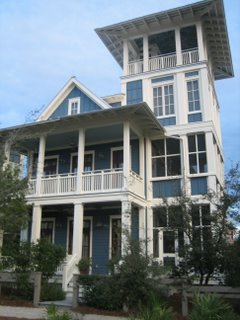

The town green is beautiful however, and when we were there the paths were lined with candles in paper bags. Hundreds of them. I liked Watercolor’s urbanism quite a bit, the bending streets and small residential parks were fantastic, alleys accommodate garages and utilities, and there were great pathway connections to an existing natural resource preserve.



I tried to get a bit artistic with my camera to capture the sunset and night scene with the glass reeds lining the bridge over the natural resource area. Haven't quite figured out my camera yet.
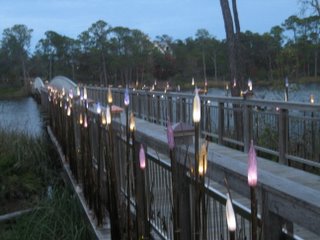
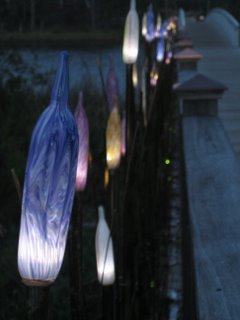

Rosemary Beach was designed by Andres Duany and his DPZ team as a critique of Seaside. The colors are less understated, the term thrown around was “saturated” color. And since Seaside had proven there was an incredible market for Atlanta/Birmingham/Dallas money looking for multi-million dollar vacation homes built in New Urbanist town center developments, the homes in Rosemary are huge. Each one is an architectural masterpiece, and as I walked around I actually became turned off. Too much architectural detail, too much beautiful architecture all in the similar Spanish style gave off the “Disneyland” feel way more than Seaside. It was too much, and with every single house screaming for attention it made it hard for the houses to really contribute to an overall whole.







I really liked the mixed-use main street and town hall though. Pretty amazing.

Duany and his team next set about to create a critique of Rosemary. The result is Alys Beach, which is just starting to be constructed and is absolutely breathtaking. Wow. You can see the obvious change in direction from the style of Rosemary. They went from saturated color to no color.

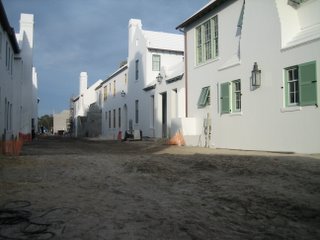


For those who don’t really know much about New Urbanism, please don’t get the impression that this is all it’s about. If this type of mega resort development is going to be built, at least it is being done the right way, and it is interesting to see the premium put on New Urbanist town center development but that is only a small fraction of what New Urbanism is all about. For example, see the site about CNU's efforts in the Mississippi Gulf Coast.
So to summarize what I saw in this small section of the Florida panhandle: the amount of effort, MONEY, and masterful new New Urbanist urban design and architecture built in such a short period of time is staggering.

1 Comments:
Do you have any examples of where New Urban design succeeded in an Urban area that was formally blighted and how many housing units does it contain?
Post a Comment
<< Home